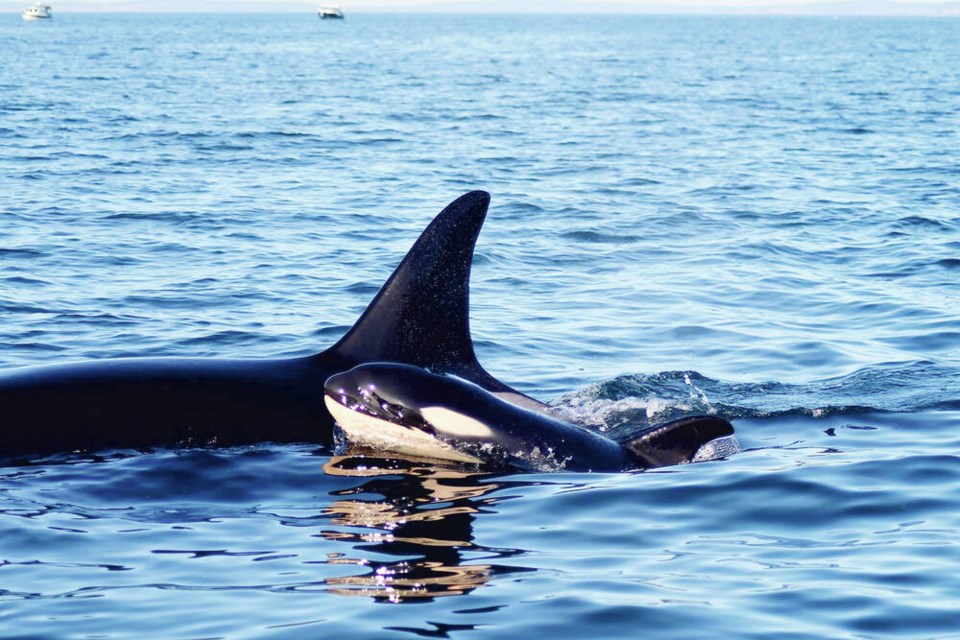In late January, the Center for Whale Research in Friday Harbor, Washington, announced the presumed death of the newest calf born to the southern resident orcas.
J60, a young male born last December, had not been seen during a two-hour encounter with all other 25 members of J pod near the San Juan Islands.
It’s just the latest calf death among the endangered whales, whose total population numbers fewer than 75. Although discouraging, the loss isn’t surprising.
A DFO study from 1990 suggests that in the Pacific Northwest, an estimated 43 per cent of all orca calves die in the first six months. A more recent estimate by the U.S. National Oceanic and Atmospheric Administration pegs calf survival in other orca populations to be about 50 per cent.
Only three calves survive from the last orca baby boom, when nine calves were born in 2015, a mere 33 per cent survival rate.
The one thing researchers do seem to be certain about is that the cause of such a high death rate is unclear.
When the animals being studied are rare and elusive, have large territories, and inhabit environments that are difficult and inhospitable to humans, lack of precision and certainty is often the result.
Only when whale carcasses are recovered can researchers determine cause of death, and the very nature of whales and the ocean means few carcasses are found.
In the scientific literature for orcas on the West Coast, orca necropsies have shown that the whales died from blunt force trauma — including from a ship strike — neonatal death, female reproductive issues, and health conditions such as infections.
Lack of Chinook salmon, the southern residents’ preferred meal, and interference during hunting, caused by vessel traffic noise, are also believed to contribute to poor orca health, which in turn affects calves’ ability to survive.
Also documented are high levels of chemical and heavy-metal contaminants such as PCBs, DDT, flame retardants, and so on in southern resident adult females and their offspring.
Last year, Canadian researchers identified toxic chemicals from oil emissions and wildfire smoke in muscle and liver samples taken from Bigg’s killer whales and southern resident killer whales.
I find it interesting that the death rate among young orca calves is so similar to the historical death rate of human infants.
Parish and other historical records, as well as remains in cemeteries and gravesites in many parts of the world, indicate that for much of recorded history, only 1 in 2 human children reached the age of 15.
The data available indicate that no matter where people lived, if they had kids before 1900, they faced the very real possibility of losing half of their children to hunger, disease, accidents and violence before they grew up.
If anything, say the researchers who compiled most of the data in a 2013 review study, the approximately 50 per cent child death rate for much of human history likely underestimates the real number.
Death records often weren’t produced for children, and child burial remains are often incomplete.
Only when antibiotics, improved medical care, and sanitation and drinking-water treatment and standards became mainstream in many areas in the 20th century did child survival rates improve.
Now, in most parts of the world, only about one child in 25 dies. (In Canada, fewer than one in 100 kids dies.)
The most impoverished, unstable countries lag behind, but even there, eight or nine kids out of 10 survive childhood.
Bringing antibiotics and veterinary care to wild orcas would be difficult or impossible, but it is hoped that government-supported projects to boost salmon populations, limit vessel interference, and lower human-caused marine noise will support orca-calf survival, as would cleanup of contaminant-leaching harbours and other coastal sites.
Such efforts will take time to translate into increased orca numbers.
Although we can’t expect dramatic decreases in calf mortality, such as those humans experienced, when fewer than 75 southern resident killer whales remain, any improvement in calf survival would be welcome.
>>> To comment on this article, write a letter to the editor: [email protected]



